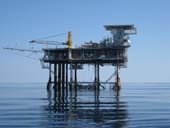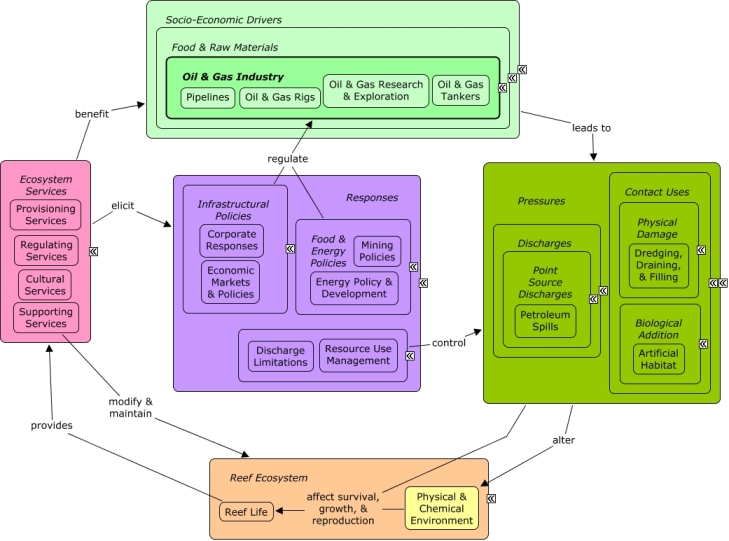ReefLink Database

Oil & Gas Rigs
Oil and Gas Rigs are the apparatus used to support drilling for natural oil and gas (both on land and off-shore).
CMap

CMap Description
The Oil & Gas Industry depends on a number of physical structures, including pipelines and oil rigs, which may create artificial habitat for fish and invertebrates. Dredging may be needed to construct pipelines, and can damage reef habitat as well as deposit large amounts of sediment in the physical & chemical environment. Activities within the Oil & Gas Industry, including pipelines, tankers, and rigs pose a risk for petroleum spills, which may contaminate the reef ecosystem, affecting growth and survival of reef life. The oil industry benefits indirectly from ecosystem services that improve the well-being of other sectors, such as tourism & recreation, which drive coastal development and the need for energy. Decision-makers can regulate the Oil & Gas Industry through energy policies, including limiting the locations and nature of activities or requiring high standard technology. Consumers may pressure the Oil & Gas Industry to respond to environmental concerns by adopting practices that minimize risk.Citations
More than 50 citations. Click here to load.
| Citation | Year | Study Location | Study Type | Database Topics |
|---|
Management Options
| Management Option | Description | Sources | Database Topics |
|---|---|---|---|
| Damage Assessment, Documentation & Response: Coordinated Oil & Hazardous Spill Response | This management option calls for developing unified response protocols to deal with containment and clean-up of oil spills. This is important to protect corals, mangroves, and seagrasses from adverse impacts of hazardous materials. Given the limited number of spills and the importance of responding quickly, interagency coordination of reporting and response is essential for success. | NOAA Marine Sanctuary Program. 2007. Florida Keys National Marine Sanctuary revised management plan. National Ocean Service, Key West, FL. Puerto Rico and USVI Area Planning Committees. 2008. Hazardous Substances Pollution Area Contingency Plan. Puerto Rico and the U.S. Virgin islands. |
Collaboration & Partnering; Decision Support; Discharges; Ecosystem Monitoring & Restoration; Energy Policy & Development; Environmental Monitoring & Restoration; Large Ships; Oil & Gas Industry; Oil & Gas Rigs; Oil & Gas Tankers; Petroleum Spills; Pipelines; Point Source Discharges; Remediation; Resource Use Management; Security & Public Administration Policies; Small Boats; Toxics; Transportation; Water Transportation; Waterborne Discharges |
| Energy Policy & Development: Oil and Gas Rig Maintenance and Use Regulations | There are regulated procedures and documentation required during production operations to prevent major incidents that may harm workers or the environment. A major part of incident prevention is inspection and maintenance. | Cultural Services; Discharge Limitations; Discharges; Energy Policy & Development; Infrastructural Policies; Natural Gas & Electric Power; Oil & Gas Industry; Oil & Gas Rigs; Petroleum Spills; Point & Mobile Source Controls; Point Source Discharges; Provisioning Services; Toxics; Utilities; Utility Policies | |
| Energy Policy & Development: Oil and Gas Rig Construction Regulations | The Minerals Management Service (MMS) has several requirements for leasing and permits for construction of new drilling rigs and platforms. Placement is very important so as to not interfere with other uses or the environment. These permits also cover exploratory structures for research and test sites. | Minerals Management Service. 2006. Leasing Oil and Natural Gas Resources. U.S. Department of the Interior. |
Civil Engineering & Construction; Construction Codes & Projects; Discharge Limitations; Discharges; Economic Markets & Policies; Energy Policy & Development; Infrastructural Policies; Infrastructure; Manufacturing & Trade Policies; Natural Gas & Electric Power; Oil & Gas Industry; Oil & Gas Research & Exploration; Oil & Gas Rigs; Permitting & Zoning; Petroleum Spills; Point & Mobile Source Controls; Point Source Discharges; Provisioning Services; Toxics; Utilities; Utility Policies |
| Restoration: Environmental Remediation | Environmental Remediation is a type of restoration that's focus ranges from Brownfields to Oil Spills to Hazardous Waste Sites. These restoration activities aim to restore the site to a previous condition, or to a condition that is not a threat to human health or other forms of life. Several standards can be used to determine when remediation is necessary and to what extent the environment should be restores. Biocriteria can be used to determine the degree of degradation to biological components of the site. Often it is the presence of a particular pollutant in the soil, water or air, which is above acceptable limits and will not degrade fast enough over a short period of time and therefore must be removed. Physical and chemical water quality criteria can be used to set maximum acceptable limits of water quality parameters. Air quality criteria can be used to set acceptable maximum and minimum air standards for remediation. | Office of Solid Waste and Emergency Response. 2005. Contaminated Sediment Remediation Guidance for Hazardous Waste Sites. EPA-540-R-05-012, US Environmental Protection Agency. Environment Protection Authority. EPA Guidelines for Environmental management of on-site remediation. Environment Protection Authority, Adelaide, Australia. |
Applied Chemicals; Biocriteria; City Planning; Decision Support; Discharge Limitations; Discharges; Ecosystem Monitoring & Restoration; Environmental Monitoring & Restoration; Environmental Monitoring, Mapping, & Scientific Research; Food, Beverage, & Tobacco Products; Health; Health Policies; Landuse Management; Littering; Manufacturing & Trade; Metals, Electronics, & Machinery Products; Military; Mining; Mining Policies; Mitigation; Monetary Valuation; Nutrient & Contaminant Processing; Oil & Gas Industry; Oil & Gas Rigs; Oil & Gas Tankers; Petroleum Spills; Physical & Chemical Water Quality Criteria; Pipelines; Point Source Discharges; Public Administration; Remediation; Security; Solid Waste Disposal; Supporting Services; Toxics; Valuation; Waste Management; Waste Management Policies; Wastewater Discharge; Waterborne Discharges; Wood, Plastics, & Chemical Products |
| Water Quality Management: Protection of Resources from Hazardous Materials & Spills | Wherever possible, take actions to decrease the likelihood of hazardous materials spills near corals. Even when risks are reduced significantly, spills may still occur, necessitating contingency plans (#56). In order for reef managers to stay informed of the latest spills/updates, a spill-reporting system should be established along with a geo-referenced database that keeps track of all spills within a certain distance of reefs. | NOAA Marine Sanctuary Program. 2007. Florida Keys National Marine Sanctuary revised management plan. National Ocean Service, Key West, FL. Puerto Rico and USVI Area Planning Committees. 2008. Hazardous Substances Pollution Area Contingency Plan. Puerto Rico and the U.S. Virgin islands. USCG. 2007. Hazardous Substances Pollution Area Contingency Plan. Florida Keys. |
Discharge Limitations; Discharges; Energy Policy & Development; Food & Energy Policies; Food & Raw Materials; Large Ships; Oil & Gas Industry; Oil & Gas Rigs; Oil & Gas Tankers; Petroleum Spills; Pipelines; Point & Mobile Source Controls; Point Source Discharges; Small Boats; Toxics; Transportation; Waste Management; Waste Management Policies; Water Transportation; Waterborne Discharges |
Laws
| Legal Citation | Purpose of Law | Management Organization | Database Topics |
|---|---|---|---|
| Clean Air Act, 42 United States Code §§ 7400 et seq. | To ensure Americans have clean air to breath, and to protect the environment from air pollution. Regulates air emmissions from area, stationary and mobile sources. Charges federal land managers with direct responsibility to protect the "air quality and related values" of land under their control. The "related values" include fish and widlife and their habitats. The Clean Air Act is the law that defines EPA's responsibility for protecting and improving the nation's air quality and the stratospheric ozone layer. Application to Coral Reefs:The Act would decrease carbon dioxide emissions from sources in the United States, thereby making a contribution toward reducing ocean acidification, which is one of the problems contributing to coral reef decline. Legislative Actions:Response will differ from State to State because many Sates have been delegated to administer the Clean Air Act. However, States cannot have air quality standards less stringent then the federal standards. State air pollution agencies hold permit hearings and fines industries that violate air quality limits. States must develop state implementation plans that require approval by EPA. Comments:The 1990 amendments authorized the Acid Deposition Control Program, a program to control 189 toxic pollutants, established permit program requirements, expanded and modified the attainment of National Ambient Air Quality Standards, and expanded and modified enforcement authority. |
United States Environmntal Protection Agency Jurisdiction: United States |
Carbon Storage & Cycling; Climate Regulation; CO2; Energy Policy & Development; Environmental Monitoring, Mapping, & Scientific Research; Greenhouse Gas Emissions; Improved Technology; Mineral, Rock, & Metal Mining; Natural Gas & Electric Power; Non-Greenhouse Gas Emissions; Nutrient & Contaminant Processing; Nutrients; Oil & Gas Research & Exploration; Oil & Gas Rigs; Point & Mobile Source Controls; Political Pressure; Transportation Policies; Wood, Plastics, & Chemical Products |
| Revised Florida Keys National Marine Sanctuary Management Plan §§ Public Law 101-605 (HR 5909, Public Law (2007). | The document is a report on the results of NOAA's five year review of strategies and activities detailed in the 1996 Final Management Plan and Environmental Impact Statement for the Florida Keys National Marine Sanctuary. Application to Coral Reefs:The plan specifically addresses preserving and enhancing Sanctuary resources including four national wildlife refuges, six state parks, three state aquatic preserves, Key Largo Marine Sanctuary, Looe Key Marine Sanctuary and a total of 2,900 square nautical miles of coastal waters and numerous coral reefs. The sanctuary ecosystems are facing specific threats including direct human impacts such as vessel groundidngs, pollution and overfishing. Legislative Actions: Comments: |
National Oceanic and Atmospheric Administration with the Florida Department of Environmental Protection and the Florida Fish and Wildlife Conservation Commission as Co-trustees Jurisdiction: US Federal Waters; Designated Marine Areas |
Anemones & Zooanthids; Apex Fish Predators; Ballast Discharge; Coastal Development; Commercial Fishing Boats; Complex Habitat & Resources; Coral; Cruise Ships; Dive, Snorkeling, & Swimming Tourism; Economic Markets & Policies; Educational & Research Opportunities; Environmental Education & Outreach; Existence Value & Sense of Place; Fish; Fishing & Harvesting Management; Littering; Lobster, Crab, & Shrimp; Marine Debris; Natural Gas & Electric Power; Non-point Source Runoff; Nutrients; Ocean Acidity; Oil & Gas Research & Exploration; Oil & Gas Rigs; Recreational Opportunities; Reef Habitat; Reef Inhabitants; Seastars; Sediment; Sponges; Tourism & Recreation Policies; Waste Management; Waste Management Policies; Waterborne Discharges |
